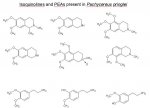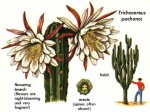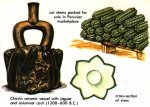HALLUCINOGENIC PLANTS
by RICHARD EVANS SHULTES
Illustrated by ELMER W. SMITH
GOLDEN PRESS - NEW YORK 1976
Western Publishing Company, Inc.
pp 100-112
SAN PEDRO (Trichocerous pachanoi) is a large columnar cactus widely cultivated as a hallucinogen in the Andes of Peru, Ecuador, and Bolivia. The natives, who also call it aguacolla, or giganton, recognize several "kinds," which differ mainly in the number of ribs, the most common type having seven. This cactus is sometimes planted along fields as a fence row to keep sheep and cattle from grazing.
An intoxicating drink called cimora is made from the San pedro cactus. Short lengths of the stem, often sold in native markets, are sliced like loaves of bread and then boiled in water for several hours, sometimes with superstitious objects such as cemetary dust and powdered bones.
Although cimora is often made from San Pedro alone, several field researchers indicate that a variety of other plants may sometimes be added to the brew. These include the cactus Neoraimondia macrostibas, an Andean species the chemistry of which has not yet been determined; the shrub Pedilanthus tithymaloides of the castor oil family; and the campanulaceous Isotoma longiflora. All these plants may have biodynamic constituents. On occasion, other more obviously potent plants are added - Datura, for example.
Only recently have researchers become aware of the importance of the "secondary" plant ingredients often employed by primitive societies. The fact that mescaline occurs in the San Pedro cactus does not mean that the drink prepared from it may not be altered by the addition of other plants, although the significance of the additives in changing the hallucinogenic effects of the brew is still not fully understood.
Cimora is the basis of a folk healing ceremony that combines ancient indigenous ritual with imported Christian elements. An observer has described the plant as "the catalyst that activates all the complex forces at work in a folk healing session, especially the visionary and divinitory powers" of the native medicine man. But the powers of San Pedro are supposed to extend beyond medicine; it is said to guard houses like a dog, having the ability to whistle in such unearthly fashion that intruders flee in terror.
Although San Pedro is not closely related botanically to peyote, the same alkaloid, mescaline, is responsible for the visual hallucinations caused by both. Mescaline has been isolated not only from San Pedro but from another species of Trichocereus. Chemical studies of Trichocereus are very recent, and therefore it is possible that additional alkaloids may yet be found in T. pachanoi.
Trichocereus comprises about 40 species of columnar cacti thot grow in subtropical and temperate parts of the Andes.
There is no reason to suppose that the use of the San Pedro cactus in hallucinogenic and divinatory rituals does not have a long history. We must recognize, certainly that the modern use has been affected greatly by Christian influences. These influences are evident even in the naming of the cactus after Saint Peter, possibly stemming from the Christian belief that Saint Peter holds the keys to heaven. But the overall context of the ritual and our modern understanding of the San Pedro cult, which is connected intimately with moon mythology, leads us to believe that it represents an authentic amalgam of pagan and Christian elements. Its use seems to be spreading in Peru.






